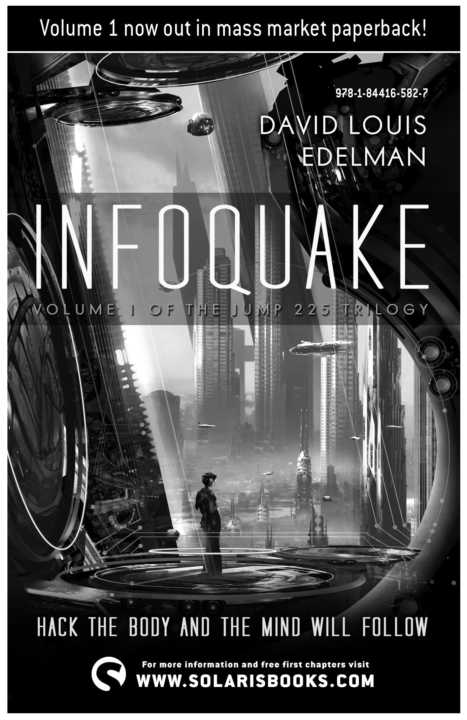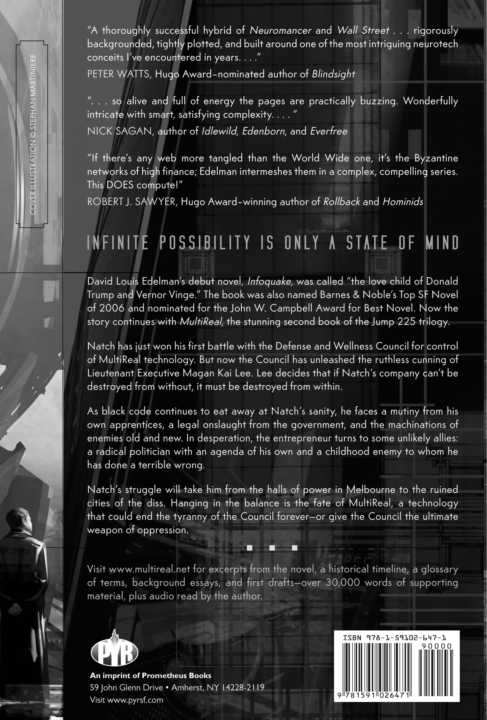Multireal (74 page)
Authors: David Louis Edelman
Tags: #Fiction - Science Fiction, #High Tech, #Science Fiction & Fantasy, #General, #Science Fiction, #Science Fiction - General, #Corporations, #Fiction, #Space Opera, #Political, #Fantasy, #Adventure

Given the importance of interplanetary shipping to the offworlders
in Luna, Mars, and the orbital colonies, OrbiCo has often been accused
of taking bribes-or at the very least, of being very dependent on the
whims of its political sponsors.
OrbiCo freight ships tend to be very utilitarian in nature. Bandwidth restrictions on interplanetary flights are such that networks like
multi, the Jamm, and the Sigh are not accessible on OrbiCo ships
(except when in port).
Marcus Surina famously declared that teleportation would provide an
end to the "tyranny of distance." Various multi network engineers have
made similar declarations. And yet, three and a half centuries into the
Reawakening, people still physically travel from place to place in large
numbers.
Current trends indicate that Surina's words may indeed prove to be
prescient, however. Declining ridership on the tube and the hoverbirds
(and the still-dismal adoption rate of teleportation) point to a society
that may one day live out its entire existence in virtual settings.
Conservation advocates such as those in Creed Conscientious warn
that such an attitude can only lead to an eventual bandwidth crisis and
universal disaster.
ON DARTG U N S
AND DISRUPTORS
MODERN WARFARE
The nature of warfare underwent a dramatic shift in the early years of
the Reawakening. Improvements in OCHRE technology and bio/logic
programming made it abundantly clear to battle tacticians that oldfashioned weapons were simply not up to the challenge of modern
combat.
The new medical knowledge and the rapid-healing capabilities of
OCHREs (not to mention advances in body armor) made constructing
a lethal projectile weapon a much more difficult task. In such a world,
even advanced biological and chemical weaponry quickly became outmoded.
Nuclear weapons programs were never restarted after the tumult
and chaos of the Autonomous Revolt, in which several smaller nuclear
strikes were executed. The death of the nation-state ensured that there
were no large, well-funded organizations with the wherewithal and
desire to construct atomic weapons. The advent of multi and the Data
Sea made bombs increasingly irrelevant when enemies were scattered
around the globe and rarely present in large numbers.
So combat tacticians of the Reawakening developed the dartgun.
The standard weapon of modern times is the dartgun. Much like their
ancestors from antiquity, dartguns shoot thin, needlelike projectiles at
great distances. But whereas ancient darts were often tipped with poisons and neurotoxins, modern darts are loaded with microscopic
OCHREs containing self-executing black code programs.
Weapons programmers have grown remarkably proficient at creating OCHREs that can spread through the body and immobilize or
kill an adversary within fractions of a second. Much of this is accomplished with controlled radio and subaether transmissions from the
infecting OCHREs that interact with other machines implanted in the
body. The complexity of the OCHRE system ensures there will always
be loopholes for black code writers to exploit.
While it might seem like body armor could easily neutralize the
threat of OCHRE-tipped darts, weapons engineers have become so
proficient at creating armor-piercing darts as to render this strategy
useless. Modern tacticians tend to focus on bio/logic defenses against
invading code instead.
Multi disruptors (often simply called "disruptors") were originally
designed with one purpose in mind: to forcefully cut someone's multi
connection. Before such weapons came into existence, there was
nothing stopping an army from sending a multied intelligence agent
into the midst of an enemy force. Such fears were also drastically
slowing public adoption of the technology.
Common belief states that the Defense and Wellness Council initiated disruptor research as a way to safeguard the multi system.
Having such weapons available, so the reasoning went, made seditious
elements less likely to attack the multi system itself.
It has become public knowledge, however, that the Council has
transformed the multi disruptor from a purely defensive weapon into
an offensive one. Various drudge reports claim these advanced disruptors can actually inject programming code into an enemy's bio/logic
systems, in the same fashion as an OCHRE-tipped dart. The Council
has been loath to publicize or even admit the existence of these
weapons, however, fearing that such actions might lead to widespread
panic and abandonment of the multi system.
Probably the most significant piece of legislation to make its way
through the government in the early 200s was the New Warfare Act
of 221. This bill legalized nonlethal warfare and set the ground rules
for nearly all conflicts that have followed since.
The bill essentially allows citizens to deploy nonlethal force in a
wide variety of circumstances. As a consequence, private security has
become a huge business, with every organization from creeds to
bureaucrats to L-PRACGs hiring its own private force.
Proponents of the New Warfare Act say this legislation has drastically reduced the casualties of conflict and pushed opposing parties to
discuss their grievances in a more civilized fashion. But detractors
point to the thousands of private security forces with conflicting
agendas who feel no compunction about shooting first and asking
questions later.
The most controversial provision of the New Warfare Act actually
requires L-PRACGs to leave security "trapdoors" in their members'
OCHRE systems that are only accessible to the central government.
The goal was to standardize weapons systems and prevent an escalating
technology war. This provision drew (and continues to draw) public
outcry and scorn, with libertarian activists calling it "legalized slavery
to the Defense and Wellness Council." Few L-PRACGs to date actu ally comply with this law. Thus far, the Defense and Wellness Council
has not sought to enforce it-although this may be because the
Council's weapons systems are still effective enough to overcome most
private programming defenses anyway.
The author would like to thank the following individuals for their editorial contributions to this book: Lou Anders, Bruce Bortz, Cindy
Blank-Edelman, Jerome Edelman, Deanna Hoak, and Philip Mansour.
For their contributions in publicizing and promoting his work, the
author would like to thank: John Joseph Adams, Paul Goat Allen, Lou
Anders, Matthew Arnold, Eric Beck, Rob Bedford, Carrie Blakeway,
Darrell and Marsha Blakeway, Cindy and David Blank-Edelman, the
good folks at Borderlands Books, Bruce Bortz, Tobias Buckell, Paul
Cornell, Ellen Datlow, the other bloggers at DeepGenre, Michael de
Gennaro, Thomas Doyle, Jerome and Barbara Edelman, Deborah and
Steve Edelman-Blank, Kate Elliott, Marc and Kathy Estafanous, Nat
Forgotson, Brent Garland, Denise Iger, Matthew Jarpe, Katharine
Kerr, Mindy Klasky, Rick Kleffel, Mary Robinette Kowal, George
Mann and the folks at Solaris Books, Philip and Erinn Mansour, Jill
Maxick, Ian McDonald, Eugene Myers, Steven Oliverez, Cat Rambo,
Paul Raven, Chris Roberson, Suzanne Rosin, Nick Sagan, Rob Sawyer,
John Scalzi, the other authors at SFNovelists.com, Kevin Smokier, Tim
Spalding and the folks at LibraryThing, Peter Watts, Andrew
Wheeler, and Sean Williams.
A special thank you to everyone at Pyr, especially Lou Anders,
Peggy Deemer, and Jill Maxick.
Final thanks go to Victoria Blakeway Edelman, who in addition to
helping out with all of the above, made the author take out Ferris from
this book too.
DAVID LOUIS E D E L M A N is a Web designer, programmer,
and journalist. He lives with his wife, Victoria, near Washington, DC.
Over the past twelve years, Mr. Edelman has programmed Web
sites for the US Army and the FBI, taught software to the US Congress
and the World Bank, written articles for the Washington Post and the
Baltimore Sun, and directed the marketing departments of biometric
and e-commerce companies.
His first novel, Infoquake, was nominated for the John W. Campbell Memorial Award for Best Novel. Barnes & Noble called the book
"the love child of Donald Trump and Vernor Vinge" and named it the
Top SF Novel of 2006. Mr. Edelman's short fiction has also been featured in the Solaris Book of New Science Fiction, Volume Two. He is a
member of the popular DeepGenre and SFNovelists blogs.
Mr. Edelman was born in Birmingham, Alabama, in 1971 and
grew up in Orange County, California. He received a BA in creative
writing and journalism from Johns Hopkins University in 1993.
E-mail: [email protected]
Web site: http://www.davidlouisedelman.com
On Facebook: http://www.facebook.com/p/David_Louis
_Edelman/507439981
On LibraryThing: http://www.librarything.com/profile/DavidLouis
Edelman
On LinkedIn: http://www.linkedin.com/in/davidlouis edelman
On Livejournal: http://david-l-edelman.livejournal.com
On MySpace: http://www.myspace.com/davidlouisedelman

*For a more detailed synopsis of the events of Infoquake, book 1 of the
Jump 225 Trilogy, see appendix A.



